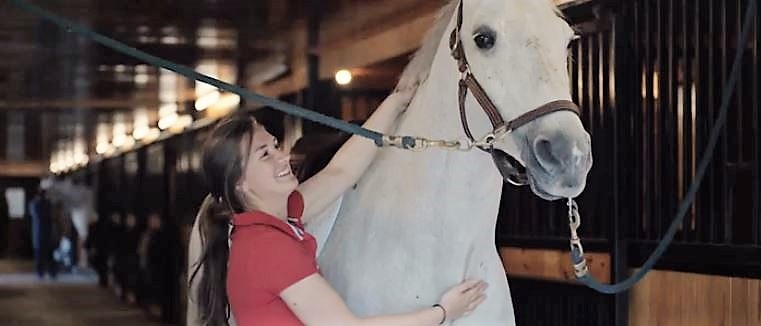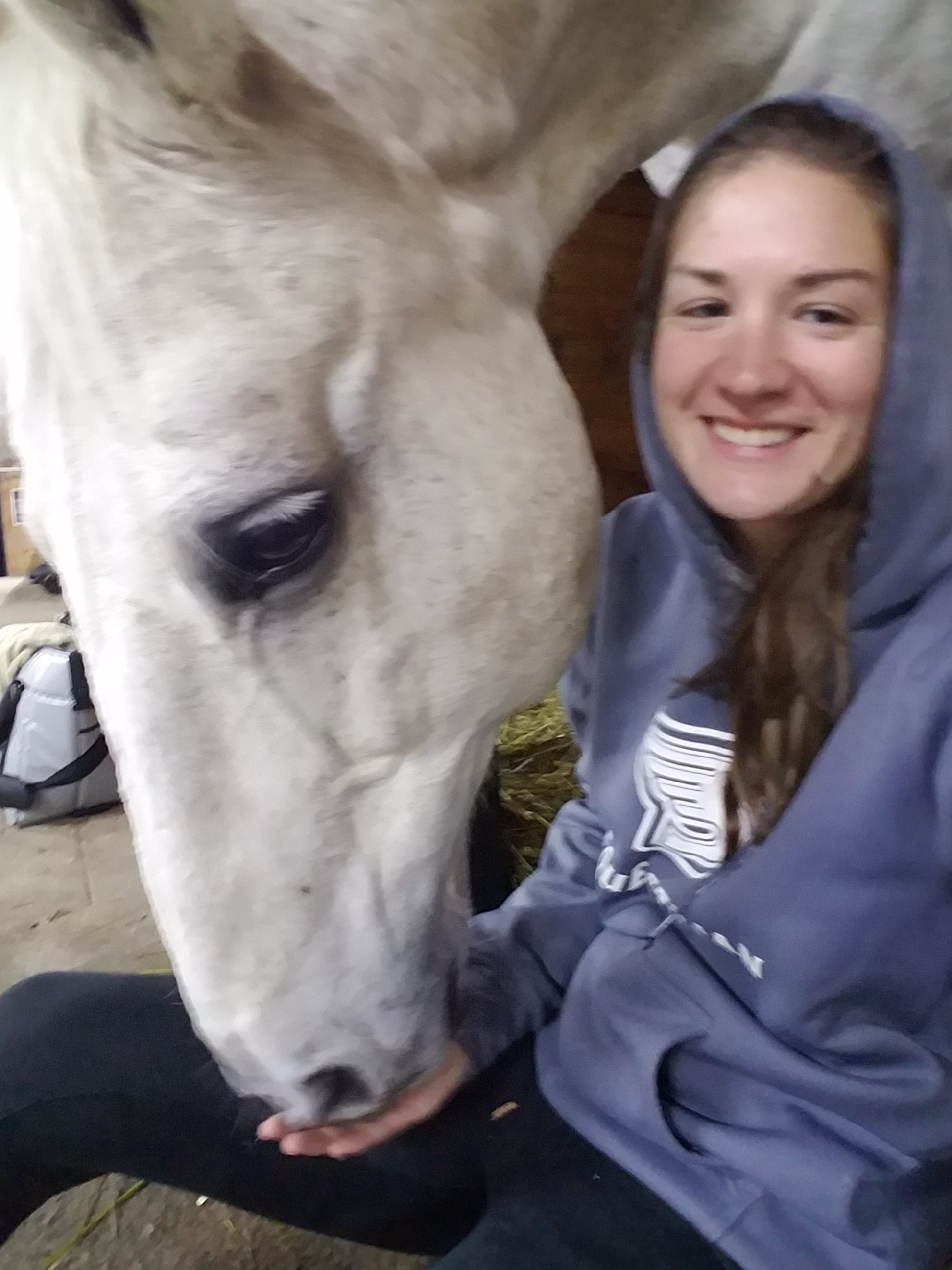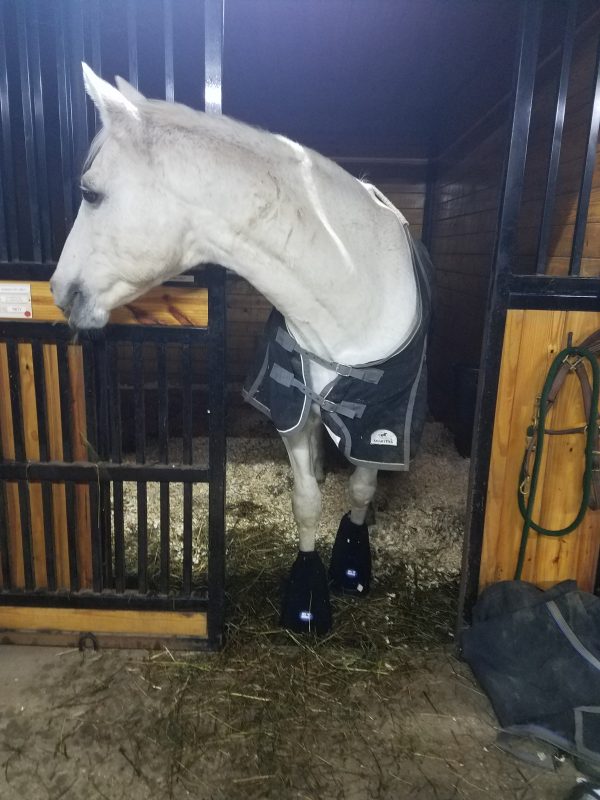Living with Laminitis
I’ve had my horse Indy since 2005, when I was only twelve years old and he was six. Together we competed up and down the east coast starting at the 2’6” Baby Green Hunters and moving all the way up to the 3’6” Jr. Hunters and even a few 4’6” International Hunter Derbies. Indy is no doubt my horse of a lifetime and I am beyond grateful for the special bond we share.

These days Indy is retired from competing, but I still spend as much time as possible with him, grooming him (he’s gray, so that’s a full-time job on its own) and going for nice long walks. Back in September, we were on a walk and something just wasn’t right. He wasn’t acting like his goofy self and I thought maybe he was stepping ever so slightly short with his left front. So, I jogged him and sure enough, he was lame. There was no heat or swelling, so I consulted with my barn manager and we thought it could be a stone bruise. I packed his feet for a few days and while he improved slightly, he still wasn’t right. Luckily my vet was coming out to look at some other horses, so I added Indy to her list.
On the day of the vet appointment, I was at work had the worst feeling. I started jumping to all the worst-case scenarios in my head. I get the call and immediately burst into tears. Indy has laminitis. I was completely distraught, but one great thing about working at SmartPak is when something is wrong with your horse, everyone gets it, and they know what questions not to ask. One of my co-workers (and her dog) took me outside for a walk, and some more crying. Another great thing about working at SmartPak is the endless amount of equine health knowledge flowing through the building. So, when I finally pulled myself together, I went and talked to a bunch of other SmartPakers about various management practices.
“I could feel bad, but I didn’t have to feel alone.”

Per my vet, the most immediate thing that Indy needed at the time was to have his feet iced as much as possible. We iced every day for four months, multiple times a day, sometimes for up to 8 hours. After trying (and struggling with) a lot of various methods for icing, I came across the Ice Horse Pro Therapy Laminitis Boot (Item # 28493). One great thing about these ice boots is that I could pull Indy out of his stall, put the boots on, and walk him right back into his stall with them on. The fit is incredibly secure, so I felt confident leaving him unsupervised in them, especially knowing he’s such a good citizen even when not being watched. This was very helpful when icing for 8 hours a day, for both Indy’s comfort and my own peace of mind. The ice packs in these boots will stay cold for up to two hours, and they also make it very easy to swap the ice packs out for new ones while the boot is still on. For that reason, I also ended up getting extra Ice Horse Cold Capsule™ Inserts (Item #28494), 12 to be exact. This was super helpful for our frequent changes and maximum icing.

One of the other instructions from my vet was for Indy to receive the non-steroidal anti-inflammatory drugs, bute, every day at least for the foreseeable future. This was meant to help with the inflammation and keep him more comfortable. Since I was worried about the stress that NSAID could be having on his stomach, my vet also recommended that he receive a ¼ of a tube of UlcerGard (Item #12668) daily for as long as he was getting the bute.
Other management practices included removing all grain from his diet, soaking all of his hay for at least an hour, and – probably the most upsetting to Indy – no more sugary treats like (his favorite) bananas.
I also completely updated his SmartPak to ensure that his supplements were supporting his new nutritional needs. Especially with his laminitis, having him on SmartPaks makes it super easy for me to know he’s getting exactly what he needs when he needs it. I kept him on SmartDigest Ultra Pellets (Item #22041) to help manage any digestive stress but switched from the powder to the pellets since he wasn’t getting grain anymore. Plus, I love the added peace of mind from ColiCare. My vet recommended putting Indy on resveratrol, a powerful antioxidant that can help to maintain healthy blood sugar levels and support comfortable movement. To support him in this area I added SmartStride Ultra Pellets (Item #25015). Last, but not least, I added SmartMetabo-Lean Pellets (Item #17885) to help support proper insulin function. I love that all SmartSupplements have no added sugar – so I can feel good about feeding them to Indy even with his laminitis. Plus, they’re all picky eater approved so even though he’s not getting any grain he gobbles them up with no problem!
Managing Indy’s laminitis has certainly been a long, physically, and emotionally exhausting journey, but I will continue to do everything in my control to keep him comfortable and happy!4
For more information on laminitis, check out this helpful article written by our Staff Veterinarian, Dr. Lydia Gray: https://www.smartpakequine.com/content/laminitis-causes